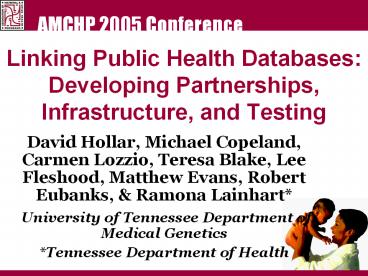Linking Public Health Databases: Developing Partnerships, Infrastructure, and Testing PowerPoint PPT Presentation
1 / 31
Title: Linking Public Health Databases: Developing Partnerships, Infrastructure, and Testing
1
Linking Public Health Databases Developing
Partnerships, Infrastructure, and Testing
- David Hollar, Michael Copeland, Carmen Lozzio,
Teresa Blake, Lee Fleshood, Matthew Evans, Robert
Eubanks, Ramona Lainhart - University of Tennessee Department of Medical
Genetics - Tennessee Department of Health
2
Electronically Linked Health Databases
- Improve health care delivery
- Provide single secure website access
- Provide comprehensive medical data
- Reduce redundancies medical errors
- Long-term tracking
- Avoid lost cases
3
Tennessee Genetics Plan
- The purpose of the statewide genetics plan is to
integrate the Newborn Genetic Screening (NBS)
Program and other genetic services into the
Information Technology (IT) Plan to assure an
adequate public health infrastructure and to
coordinate genetic services with all other
programs for children with special health - care needs (CSHCN).
4
Major Goals
- Develop an electronic child health profile that
links data from Newborn Genetic/Metabolic
Screening, Hearing Screening, Birth Certificate,
and Vital Records for all children born in
Tennessee. - Make this information available in a secure,
accessible format for - providers, with permission.
5
Tennessee Child Health Profile
6
Partners
- UT Department of Medical Genetics
- Tennessee Department of Health
- Office of Policy, Planning, Assessment
- Office of Information Technology
- Office of MCH
- Tennessee State Laboratory
- Genetics Newborn Screening
- Newborn Hearing Screening Program
7
Project Development
- IRB Approvals from
- UT Graduate School of Medicine
- Tennessee Department of Health
- Project Approval from
- Tennessee Office of Information Resources,
Department of Finance and Administration
8
Project Guidance
- State Genetics Coordinating Committee
Three Genetic Centers EPSDT Bureau of TennCare
TN Department of Health EPSDT Bureau of TennCare
TEIS TN Dept. Education TN Division of Mental Retardation Services
Child Development Centers Universities
Council on Developmental Disabilities TN Dept. Mental Health Dev. Dis. Consumers
Council on Developmental Disabilities TN Dept. Mental Health Dev. Dis. Legislators
9
Children with Genetic/Metabolic Conditions in
Tennessee, 2003
- n 125 confirmed (78,841 live births)
- Six Conditions
- Phenylketonuria
- Congenital Hypothyroidism
- Hemoglobinopathies
- Galactosemia
- Congenital Adrenal Hyperplasia
- Biotinidase Deficiency
10
Conditions Added in 2004
- Homocystinuria
- Maple Syrup Urine Disease (MSUD)
- Medium Chain Acyl CoA Dehydrogenase Deficiency
(MCADD) - 50 Other Amino Acid, Organic Acid,
- Fatty Acid Oxidation Disorders
11
Confirmed Positives (2004)
Phenylketonuria 7
Galactosemia 25
Congenital Hypothyroidism 57
Hemoglobinopathy 54
CAH 7
Biotinidase Deficiency 5
MCAD 4
Acylcarnitines 9
Amino Acids 1
N 80,976 births
12
Major Tasks
- Developing Partnerships
- Sharing Data
- Major Successes
- Setbacks and Challenges
- Linking Data
- Implementation
13
Developing Partnerships
- Identify Key Holders of Data
- Identify Liaison Experts
- Communication with Directors
- Work through Influential Supporters
- Clearly Outline Project Benefits
- Identify Address Partner Needs
- Maintain Intensity Momentum
14
Sharing Data
- Address Data Silo Issues
- Demonstrate Project Efficacy
- Communicate with Data Holders
- Insure Data Integrity Security
- Accountability
15
Major Successes
- Data Sharing Agreements
- Linkages for Three Databases
- OIR Project Approval
- Two IRB Approvals
- Involvement of Case Managers
- AHRQ IT Planning Grant Award
- Volunteer e-Health Collaboration
16
Statewide Cooperation
17
Setbacks and Challenges
- Personnel Changes at the TN Department of Health
- Technical Issues
- Solutions Obtained through Teamwork
18
Linking Data
- Matching Records between Databases
- Identifier Issues
- Data Duplications
- Other Issues
- Approaches at Solutions
19
Matching Databases
Database Present in 1990-1995 Present in 1996-2002
NBS Alone 15 232
Birth Alone 78 6
NBS-Birth 20 (.18) 391 (.62)
Total 113 629
Number of Records 308 3733
Female .52 .52
Minority .19 .19
Stratified Random Samples (16/1 x 105) Stratified Random Samples (16/1 x 105) Stratified Random Samples (16/1 x 105)
20
Matching Identifiers
Identifier Match 90-95 Match 96-02
Childs Last Name 1.00 .903 - .916
Childs First Name .80 .205-.255
Date of Birth .95 .995-1.00
Ethnicity 1.00 .964
Gender 1.00 .995
Mothers LN 1.00 .967-.984
Mothers FN .90-1.00 .951-.989
Mother Maiden .30 .266-.274
Mothers SSN .45-.50 .890-.923
County .70b .95m .627b ..872m
21
Implementation
- Secure Web Browser Development
- Involvement of Case Managers
- Case Manager Questionnaire
- Training Session
- Pilot Test
22
Methods of Evaluation I
- Percentage confirmed matches on subsequent passes
- Percentage of live born infants screened
- Percentage of live born infants adequately
screened - Timeliness of diagnoses timeliness of
treatments - Long-term assessment of infants
- with positive conditions for
- developmental delay, morbidity, etc.
23
Methods of Evaluation II
- Percentage of false positives per test
- Percentage of infants with pre-birth identified
medical home - Percentage of public providers submitting data to
the integrated database - Percentage of private providers submitting data
to the integrated database - User satisfaction with TN-CHP
- Parental satisfaction
24
Project Expansion
25
AHRQ IT Planning Grant
26
AHRQ Partners
- UT Department of Medical Genetics, Knoxville
- UHS, Department of Information Services
- Vanderbilt University Department of Pediatrics
-Genetic Center, Center for Child Development,
Department of Biomedical Informatics - UT Health Sciences Center (Memphis)
- Boling Center for Developmental
- Disabilities and Genetic Center
27
Statewide Cooperation!
28
Additional Collaborations
- SERGG Regional Grant
- PHII Connections Community of Practice
- Public Health Data Standards Consortium
- Correspondence with other HRSA and AHRQ grantees,
EHDI projects, etc.
29
Long Range Goal
30
Acknowledgments
- Members of the State Genetics Coordinating
Committee - Staff at the Tennessee Departments of Health
Education, TN Early Intervention Services - Support
- HRSA Grant 1 U93 MC 00230-01 and AHRQ Grant 1
P20 HS015426-01
31
For More Information
- Contact
- David W. Hollar, Jr., PhD
- (865) 544-6669
- dhollar_at_mc.utmck.edu
- Carmen B. Lozzio, MD, FACMG
- (865) 544-9031
- clozzio_at_mc.utmck.edu

